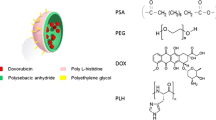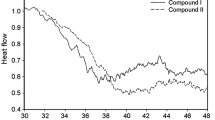Abstract
The ideal drug delivery system (DDS) should be able to deliver a therapeutic dose of drug to the target site in the body and maintain appropriate concentration over a desired period of time. Thermo/pH-responsive targeted polymeric nanocapsules (p(NIPA-co-AAc-co-GAA)) for delivery of anticancer drug (doxorubicin, DOX) were fabricated by W/O/W double emulsion solvent evaporation technique. The morphology, hydrodynamic diameter, size distribution, thermo/pH responsiveness, targeted property, anti-tumor efficacy, encapsulation efficiency, drug loading and controlled release of drug were systematically investigated. The results demonstrated that p(NIPA-co-AAc-co-GAA) nanocapsules minimized the drug leakage and reduced the toxic and side effects on normal tissues, while triggered and accelerated the release of drug in tumor tissues. It is very interesting for the site-specific release of drug to improve curative effects and reduce side effects, implying that p(NIPA-co-AAc-co-GAA) nanocapsule is a attractive candidate for DDS.





Similar content being viewed by others
References
Gandhi NS, Tekade RK, Chougule MB (2014) Nanocarrier mediated delivery of siRNA/miRNA in combination with chemotherapeutic agents for cancer therapy: current progress and advances. J Control Release 194:238–256
Kowalczuk A, Trzcinska R, Trzebicka B, Műller AHE, Dworak A, Tsvetanov CB (2014) Loading of polymer nanocarriers: factors, mechanisms and applications. Prog Polym Sci 39:43–86
Creixell M, Peppas NA (2012) Co-delivery of siRNA and therapeutic agents using nanocarriers to overcome cancer resistance. Nano Today 7:367–379
Wang Y, Wan GY, Li ZY, Shi SR, Chen BW, Li CY, Zhang LY, Wang YS (2017) PEGylated doxorubicin nanoparticles mediated by HN-1 peptide for targeted treatment of oral squamous cell carcinoma. Int J Pharm 525:21–31
Esfanjani AF, Jafari SM, Assadpour E (2017) Preparation of a multiple emulsion based on pectin-whey protein complex for encapsulation of saffron extract nanodroplets. Food Chem 221:1962–1969
Assadpour E, Jafari SM, Maghsoudlou Y (2017) Evaluation of folic acid release from spray dried powder particles of pectin-whey protein nano-capsules. Int J Biol Macromol 95:238–247
Assadpour E, Maghsoudlou Y, Jafari SM, Ghorbani M, Aalami M (2016) Evaluation of Folic acid nano-encapsulation by double emulsions. Food Bioprocess Technol 9:2024–2032
Haladjova E, Toncheva-Moncheva N, Apostolova MD, Trzebicka B, Dworak A, Petar P, Dimitrov I, Rangelov S, Tsvetanov CB (2014) Polymeric nanoparticle engineering: from temperature-responsive polymer mesoglobules to gene delivery systems. Biomacromol 15:4377–4395
Chang YW, Silas JA, Ugaz VM (2010) A direct probe of the interplay between bilayer morphology and surface reactivity in polymersomes. Langmuir 26(4):12132–12139
Li RR, Feng FL, Wang YS, Yang XY, Yang XL, Yang VC (2014) Folic acid- conjugated pH/temperature/redox multi-stimuli responsive polymer microspheres for delivery of anti-cancer drug. J Colloid Interface Sci 429:34–44
Liu X, Yu D, Jin CS, Song XW, Cheng JZ, Zhao X, Qi XM, Zhang GX (2014) A dual responsive targeted drug delivery system based on smart polymer coated mesoporous silica for laryngeal carcinoma treatment. New J Chem 38:4830–4836
Tian Q, Zhang CN, Wang XH, Wang W, Huang W, Cha RT, Wang CH, Yuan Z, Liu M, Wan HY, Tang H (2010) Glycyrrhetinic acid-modified chitosan/ poly(ethylene glycol) nanoparticles for liver-targeted delivery. Biomaterials 31(17):4748–4756
Shirakura T, Kelson TJ, Ray A, Malyarenko AE, Kopelman R (2014) Hydrogel nanoparticles with thermally controlled drug release. ACS Macro Lett 3:602–606
Zhu J, Liao L, Bian XJ, Kong JL, Yang PY, Liu BH (2012) pH-controlled delivery of doxorubicin to cancer cells, based on small mesoporous carbon nanospheres. Small 8:2715–2720
Lu Y, Sun WJ, Gu Z (2014) Stimuli-responsive nanomaterials for therapeutic protein delivery. J Control Release 194:1–19
Stuart M, Huck WT, Genzer J, Muller M, Ober C, Stamm M, Sukhorukov GB, Szleifer I, Tsukruk VV, Urban M, Winnik F, Zauscher S, Luzinov I, Minko S (2010) Emerging applications of stimuli-responsive polymer materials. Nat Mater 9:101–113
Constantina M, Bucatariu S, Ascenzi P, Simionescu BC, Fundueanu G (2014) Poly(NIPAAm-co-b-cyclodextrin) microgels with drug hosting and temperature- dependent delivery properties. React Funct Polym 84:1–9
Hu Y, Zhao NN, Li JS, Yang WT, Xu FJ (2012) Temperature-responsive porous polycaprolactone-based films via surface-initiated ATRP for protein delivery. J Mater Chem 22:21257–21264
Ma ML, Ma Y, Zhang BL, Zhang HP, Geng WC, Zhang QY (2015) Fabrication and characterization of 1 D Fe3O4/P(NIPAM-MAA-MBA) nanochains with thermo- and pH-responsive shell for controlled release for phenolphthalein. J Mater Sci 50:3083–3090. doi:10.1007/s10853-015-8868-5
He XL, Yu S, Dong YY, Yan FY, Chen L (2009) Preparation and properties of a novel thermo-responsive poly(N-isopropylacrylamide) hydrogel containing glycyrrhetinic acid. J Mater Sci 44:4078–4086. doi:10.1007/s10853-009-3588-3
Zha LS, Zhang Y, Yang WL, Fu SK (2002) Monodisperse temperature-sensitive microcontainers. Adv Mater 14:1090–1093
Zhou L, Lu ZY, Zhang X, Dai H (2006) The studies on the temperature sensitive of N-isopropylacrylamide copolymer. Polym Mater Sci Eng 22(2):165–168
Kraus K, Tieke B (2014) pH-and temperature-responsive hydrogels of acrylic acid, N-isopropylacrylamide and a non-ionic surfmer: phase behaviour, swelling properties and drug release. Colloid Polym Sci 292:3127–3135
Friedrich T, Tieke B, Stadler FJ, Bailly C (2011) Copolymer hydrogels of acrylic acid and a nonionic surfmer: pH-induced switching of transparency and volume and improved mechanical stability. Langmuir 27:2997–3005
Hu W, Zhang Y (2010) Synthesis and characterization of fluorescent composite microgels with the dual thermo- and pH-sensitive. Acta Chim Sinica 18:1855–1863
Wasserman MA, Sundell CL, Kunsch C, Edwards D, Meng CQ, Medford RM (2003) Chemistry and pharmacology of vascular protectants: a novel approach to the treatment of atherosclerosis and coronary artery disease. Am J Cardiol 91(3):34–40
Zhang J, Zhang QS, Chen XM, Tian GY (2003) Synthesis of targeting drug for antifibrosis of liver: a conjugate for delivering glycyrrhetin to hepatic stellate cells. Glycoconj J 19:423–429
Khoee S, Sattari A, Atyabi F (2014) Physico-chemical properties investigation of cisplatin loaded polybutyladipate (PBA) nanoparticles prepared by w/o/w. Mater Sci Eng, C 32:1078–1086
Liu MX, Chen LH, Zhao YH, Gan LH, Zhu DZ, Xiong W, Lv YK, Xu ZJ, Hao ZX, Chen LW (2012) Preparation, characterization and properties of liposome-loaded polycaprolactone microspheres as a drug delivery system. Colloid Surf A 395:131–136
Yang YY, Chia HH, Chung TS (2000) Effect of preparation temperature on the characteristics and release profiles of PLGA microspheres containing protein fabricated by double-emulsion solvent extraction/evaporation method. J Control Release 69:81–96
Cuggino JC, Contreras CB, Jimenez-Kairuz A, Maetto BA, Igarzabal CIA (2014) Novel poly(NIPA-co-AAc) functional hydrogels with potential application in drug controlled release. Mol Pharm 11:2239–2249
Zhang XJ, Achazi K, Steinhilber D, Kratz F, Dernedde J, Haag R (2014) A facile approach for dual-responsive prodrug nanogels based on dendritic polyglycerols with minimal leaching. J Control Release 174:209–216
Fundueanu G, Constantin M, Oanea I, Harabagiu V, Ascenzi P, Simionescu BC (2010) Entrapment and release of drugs by a strict “on-off ” mechanism in pullulan microspheres with pendant thermosensitive groups. Biomaterials 31(36):9544–9553
Salehi R, Rasouli S, Hamishehkar H (2015) Smart thermo/pH responsive magnetic nanogels for the simultaneous delivery of doxorubicin and methotrexate. Int J Pharm 487:274–284
Korsmeyer RW, Peppas NA (1984) Solute and penetrant diffusion in swellable polymers. III. Drug release from glassy poly(HEMA-co-NVP) copolymers. J Control Release 1(2):89–98
Yang XL, Luo YL, Xu F, Chen YS (2014) Thermosensitive mPEG-b-PA-g-PNIPAM comb block copolymer micelles: effect of hydrophilic chain length and camptothecin release behavior. Pharm Res 31:291–304
Acknowledgements
This work was supported by Natural Science Foundation of Tianjin (Nos. 16JCYBJC23800, 16JCZDJC37500) and Training Program of Innovation and Entrepreneurship for Undergraduates (201610058064).
Author information
Authors and Affiliations
Corresponding authors
Rights and permissions
About this article
Cite this article
He, X., Liang, F., Wang, F. et al. Targeted delivery and thermo/pH-controlled release of doxorubicin by novel nanocapsules. J Mater Sci 53, 2326–2336 (2018). https://doi.org/10.1007/s10853-017-1679-0
Received:
Accepted:
Published:
Issue Date:
DOI: https://doi.org/10.1007/s10853-017-1679-0




